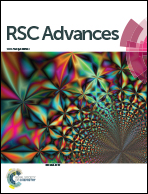Bismuth nanoparticles: an efficient catalyst for reductive coupling of nitroarenes to azo-compounds†
Abstract
The synthesis of azoarenes from corresponding nitroarenes was developed by virtue of in situ bismuth nanoparticles. A series of aromatic azo compounds can be obtained under mild reaction conditions with excellent yields.


 Please wait while we load your content...
Please wait while we load your content...